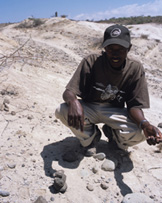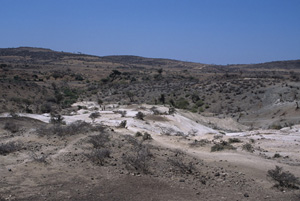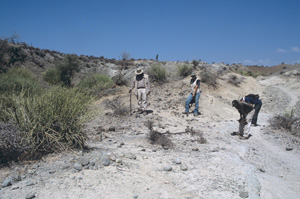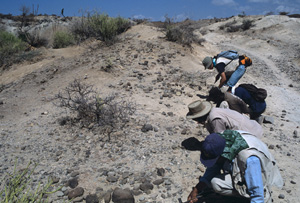2007年8月23日Nature誌に論文掲載
1000万年前の新種の大型類人猿 Chororapithecus abyssinicus
2006年から2007年のエチオピアにおける古人類学調査で、ゴリラの系統に属する可能性が高い新種の大型類人猿が発見された。
アルディピテクス・ラミダス(ラミダス猿人)が1992年に発見され、アウストラロピテクスが出現する以前のヒトの進化について、初めて垣間見ることができた。その後、1990年代末から2000年代に入り、アルディピテクス・カダバ、オロリン、サヘラントロプスが発見され、ヒト科の化石記録が少なくとも600万年前までさかのぼることが分かってきた。しかしながら、サハラ以南のアフリカにおける1200万〜700万年前のヒト上科化石がわずかしか存在しないため、アフリカの現生類人猿とヒトの系統の出現時期や様式については何もわかっていない。従来からは、ヒトとチンパンジーの分岐が500万〜600万年前、ヒトとゴリラの分岐が600万〜800万年前という、比較的新しい分岐年代が提唱されており、研究者によっては、アフリカ類人猿とヒトの起源を1000万年前ごろのユーラシア大陸の化石類人猿に求めてきた。今回の大型類人猿の化石は、ラミダス発見の地の200キロ弱南、アファール地溝帯の南端にあるチョローラ累層の1050万〜1000万年前の堆積物から出土した。特に臼歯の形態比較からゴリラと近縁な新種であるとの見解に達し、チョローラピテクス・アビシニクス(Chororapithecus abyssinicus)と命名した。
共同発表者:
河野礼子(国立科学博物館・人類研究部)
加藤茂弘(兵庫県立人と自然の博物館)
Berhane Asfaw 博士(地溝帯研究センター)
Yonas Beyene 博士(エチオピア文化省)
人類形態研究室(諏訪研究室)のトップページへ
1000万年前の新種の大型類人猿 Chororapithecus abyssinicus
2006年から2007年のエチオピアにおける古人類学調査で、ゴリラの系統に属する可能性が高い新種の大型類人猿が発見された。
アルディピテクス・ラミダス(ラミダス猿人)が1992年に発見され、アウストラロピテクスが出現する以前のヒトの進化について、初めて垣間見ることができた。その後、1990年代末から2000年代に入り、アルディピテクス・カダバ、オロリン、サヘラントロプスが発見され、ヒト科の化石記録が少なくとも600万年前までさかのぼることが分かってきた。しかしながら、サハラ以南のアフリカにおける1200万〜700万年前のヒト上科化石がわずかしか存在しないため、アフリカの現生類人猿とヒトの系統の出現時期や様式については何もわかっていない。従来からは、ヒトとチンパンジーの分岐が500万〜600万年前、ヒトとゴリラの分岐が600万〜800万年前という、比較的新しい分岐年代が提唱されており、研究者によっては、アフリカ類人猿とヒトの起源を1000万年前ごろのユーラシア大陸の化石類人猿に求めてきた。今回の大型類人猿の化石は、ラミダス発見の地の200キロ弱南、アファール地溝帯の南端にあるチョローラ累層の1050万〜1000万年前の堆積物から出土した。特に臼歯の形態比較からゴリラと近縁な新種であるとの見解に達し、チョローラピテクス・アビシニクス(Chororapithecus abyssinicus)と命名した。
共同発表者:
河野礼子(国立科学博物館・人類研究部)
加藤茂弘(兵庫県立人と自然の博物館)
Berhane Asfaw 博士(地溝帯研究センター)
Yonas Beyene 博士(エチオピア文化省)
 |
(left) Kampiro Kairente who discovered the Chororapithecus canine. In this photo, he is at the monkey phalanx, placed on the small stone cairn. This and another fossil of a possible monkey root fragment led to the Chororapithecus find. (c) 2006 Gen Suwa (right) Systematic surface examination of the Chororapithecus canine find spot. (c) 2006 Gen Suwa. Dr. Yonas Beyene (bottom), Dr. Berhane Asfaw (next), and Dr. Reiko Kono (top). |
人類形態研究室(諏訪研究室)のトップページへ

The 10-11 myr old Beticha locality. (c) 2006 Gen Suwa
Nine teeth of Chororapithecus were found here.

The February 2006 canine find spot. (c) 2006 Gen Suwa
Dr. Berhane Asfaw (left) standing at the exact find spot of the Chororapithecus canine. Dr. Reiko Kono (second left) points to the monkey phalanx spot.


